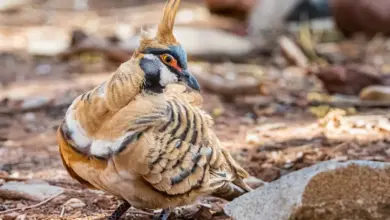Tawny Owls (Strix aluco)
The Tawny Owls (Strix aluco) – also known as Brown Owls, Grey Night Owls, or Common Night Owls – are stocky, medium-sized owls that are resident in much of Europe and southern Russia ranging into Asia and south into Africa.
In Europe, they are the most widespread of all owls, and they are the most common birds of prey found in Great Britain.
Their closest relatives are the Hume’s Owls (Strix butleri), which were previously considered one of their subspecies; as well as the larger, more northerly occurring Ural Owls (Strix uralensis), and the North American Barred Owls (Strix varia).
Brown and grey color variants occur with either brown or grey backs. Either form has pale underparts with dark streaks.
These agile flyers can reach speeds of 50 mph (80km/h).
Their main prey animals are rodents usually captured by dropping down on them and then swallowing them whole. In urban areas, a higher proportion of their diet is made up of birds, including smaller owls.
These nocturnal birds (mostly active at night) occasionally are seen hunting during the daytime; in particular when good feeding opportunities come up or whenever there is a hungry family to feed.
These owls are highly territorial and very protective of their nests and their young. In Europe, they are blamed for more injuries to humans than any other bird. Nesting females in particular are known for striking the faces of their victims with their strong, sharp claws.
Since their flight is silent and they can’t easily be seen in the dark, the victims of these attacks usually don’t notice them until it is too late.
In Great Britain alone, two people are reported to have lost an eye due to their attack – including Eric John Hosking, a well-known photographer noted for his bird photography.
Tawny Owls reach reproductive maturity when they are about one year old. The oldest recorded Tawny Owl – a captive bird in Britain – survived 27 years. The oldest known Tawny Owl in the wild lived 18 years.
In their natural habitat, most live only 4 to 6 years due to environmental factors (harsh weather conditions, poisoning, etc.) and predation (particularly at the nesting stage).
Distribution / Habitat
Tawny Owls are found throughout Europe, where they are the most common and widespread of all owls with a range that covers most of Europe, except Ireland, extreme north of Scotland, northern Russia, northern Scandinavia, Iceland, and some of the Mediterranean islands.
The European population alone is estimated to consist of 970,000–2,000,000 individuals.
… south to northwestern Africa, where they are found in Morocco, Algeria, and Tunisia;
… east to Iran western Siberia and the Caspian Sea;
… south to northwestern India, Myanmar, southern China, Taiwan, and Korea (Asia).
Traditionally, they inhabit dense forests and open woodland; however, they have adapted well to urban living and are now found in large gardens, parks, cemeteries, and farmland areas with trees.
Many have taken up residence in large cities, including London and Berlin, where they readily take shelter in abandoned buildings or the crevices of structures.
In the colder parts of their range, Tawny Owls generally remain in lowland areas up to altitudes of about 1,800 feet (550 meters). In warmer areas, they occur at higher altitudes – such as up to 9,180 feet (2,800 meters) in Myanmar aka Burma (Southeast Asia).
Subspecies, Ranges, and ID
Description
Tawny Owl measure about 15 – 18 inches (38 – 45.72 cm) in length (including the tail), have a wingspan of 32 – 41.3 inches (81 – 105 cm), and weigh between 12 – 28.2 oz (350 – 800 g).
Females tend to be about 5% longer and 25% heavier than males, but other than the size difference, males and females look alike.
The large, rounded head lacks the ear tufts typically associated with owls; and the dark-edged facial disc is either pale rufous-buff or deep buff with a reddish-brown tinge. The bill is pale olive-yellow and the feathered legs are white with some brownish speckling. The claws are blackish with dirty white bases.
As far as the plumage is concerned, two distinct color phases exist – brown and grey-plumaged birds.
An Italian study determined that brown-morph birds are usually found in denser forests and paler birds are more likely to be found in colder climates.
Intermediate plumages of tawny-buff, buff-brown, or greyish-brown have also evolved. The underparts of any form are pale/whitish and streaked with brown.
Tawny Owl Hearing
Thanks to the enhanced internal structure of the ear, they can detect low-frequency sounds at a distance. Their hearing is estimated to be better than a human’s.
Tawny Owl Vision
The Tawny Owl have an eyesight that is believed to be 100 times better than that of humans, even better than any other owls. They can spot prey that is over 1,650 feet (500 meters) away. Their eyes (irises) are dark.
Breeding / Nesting
Pairs generally maintain breeding territories and stay within them throughout the year. Depending on terrain and prey availability, these territories range in size from about 30 acres (12 ha) to 162.5 – 187.5 acres (65 – 75 ha).
As the breeding season approaches, unattached males will advertise their territories by hooting and calling, and occasionally clapping their wings together in a form of display.
Males will also reinforce the pair bonds with their mate by displaying for them. Males ready to breed may hunt at any time of the day or night to gather food to present to their mates.
Once pair bonds have been formed, the females will decide on the location of the nest.
Even though Tawny Owls are usually monogamous (pairing for life), some males may mate with several females. Nesting pairs usually spend more time together than during the rest of the year.
In Europe, mutual courtship feedings are observed during the winter – usually from December to February, with actual nesting commencing in mid-March and going on until about July.
In the southern parts of their range nesting generally commences earlier than in the northern parts.
They mostly nest in either natural tree cavities or take over nests formerly used by other birds, such as crows, ravens, Magpies, Sparrowhawks Buzzards, or squirrel dreys.
They are also known to nest in chimneys, on bare ledges, or in crevices of old buildings or cliffs. In Galloway, southwest Scotland, they are even reported to commonly nest on the ground. They have adapted well to urban living and are readily accepting suitable artificial nest boxes as well.
A clutch may consist of 1 – 6 white eggs, the average being 3. The eggs are laid at intervals of 48 hours and each egg measures about 1.84 x 1.54 inches (46.7 x 39mm).
The female alone incubates the eggs for 28 – 30 days while the male hunts and brings food to the brooding female and any nestlings. When the young are about one week old, the female usually leaves the nest for short periods to hunt as well.
The young fledge (leave the nest) when they are about 32 to 37 days old, but continue to be cared for by the parents for another month or up to 2 months, at which time they generally disperse to find territories of their own.
Diet / Feeding
Tawny Owls prey on mammals up to the size of small rabbits, insects (beetles especially), earthworms, frogs, and lizards, as well as roosting or nesting birds (Blackbirds, Woodcocks, and pigeons – sometimes even birds larger in size than themselves, such as Mallards). Occasionally, they may also take fish.
They usually hunt at night, except when having to raise hungry young. They usually glide from a roosting perch down to the ground to capture their prey, which is then quickly killed by tearing at them with their powerful claws or by directing powerful blows with their beaks to their victims’ heads.
Prey is typically swallowed whole and indigestible parts (such as bones and fur) are expelled as pellets that range in size from 1.1 – 2.75″ (30 – 70 mm) in length and 0.7 -1″ (18 – 26 mm) in width. These pellets usually have a loose texture and are grey when dry, and piles of them are usually found underneath their favorite roosting perches.
Calls / Vocalizations / Sounds
Tawny owls tend to be very vocal, and during the night their hooting and screeching calls are often heard as they announce their territories and call out to mates. Their calls are particularly common during autumn, winter, and early spring on clear, calm nights.
The male’s contact call is described as a fluting, quavering, drawn-out hoo-hoo-hooooo and the female’s as a sharpkeew-wick. Males announcing their territories, courting, or communicating to females make long drawn-out hooo sounds followed by a pause and an abrupt and subdued ha – often followed by a prolonged and resonant wavering phrase huhuhuhooo.
The female’s calls may be similar to the males’ but are usually not as phrased. The females’ contact calls are usually kewick vocalizations.
Males and females may sometimes vocalize in courtship duets consisting of characteristic ‘twit-twooo’ vocalizations. Aggression is expressed by piercing coo-wik cries.
Nesting young make cheeping calls as they call their parents to feed them.
Alternate (Global) Names
Albanian: kukuvajka e pyjeve … Arabic: ?????? ??????? … Armenian: [Antarabu ], ????????? … Asturian: Curuxu … Azerbaijani: Adi yapalaqca, Boz (Adi) yapalaqca, Boz yapalaqca … Basque: Basontza, Gamarús, urubi, Urubia … Belarusian: niajasy? šeraja, ??????? ?????, ????? ????????? … Bulgarian: gorska ululica, ?????? ??????? … Breton: Ar gaouenn penn tev, kaouenn penn-tev … Catalan: Gamarús … Chinese: ???, ??? … Cornish: perthuan … Croatian: šumska sova … Czech: puštík, Puštík obecný … Danish: Natugle … Dutch: Bosuil … Esperanto: arbara strigo, arbarstrigo … Estonian: Kodukakk … Finnish: Lehtopöllö … Faroese: músagjóð … French: Chouette hulotte … Friulian: cat?s … Frisian: wldûle … Gaelic: Cailleach-Oidhche, Comhachag Dhonn, Cumhachag … Galician: Avelaiona, Gamarús … Georgian: ?? … German: Waldkauz … Greek: (??????) ????????????, chouchouristiis, ????????????, ????????????? … Hebrew: ?????, ????? ????? … Hungarian: Macskabagoly … Icelandic: Náttugla … Irish: avelaiona, curuxa laiona, ulchabhán donn … Italian: Allocco, Allocco comune, Allocco eurasiatico … Japanese: morifukurou … Korean: ??? … Lithuanian: namine peleda, namin? pel?da, Namin?s pel?dos … Latvian: meža puce, meža p?ce … Macedonian: šumski buv, ?????? (??????) ???, ?????? ??? … Maltese: kokka … Manx: hullad ghoan … Norwegian: Kattugle … Polish: Pójdzka, Pójd?ka, puszczyk, puszczyk (zwyczajny), Puszczyk zwyczajny … Portuguese: coruja do mato, Coruja-do-mato … Romanian: huhurez … Russian: nejasyt’ seraja, Seraya Neyasyt, ??????? ???????????? ?????, ??????? ?????, ???????????? ???????, ???????????? ????? ???????, ????????????? ???????, ????? ??????? … Sardinian: cuccubaju, i-stria … Scots: cailleach-oidhche … Serbian: šumska sova, ?????? ???? … Slovak: sova lesná, sova obycajná, Sova oby?ajná … Slovenian: lesna sova … Sorbian: kiwka, spusk, kwikawa, kwikawka, sutawka, wiwka … Spanish: Acárabo Común, Cárabo, Carabo Comun, Cárabo Común … Swedish: Kattuggla …Turkish: Alaca Bayku?, Orman Bayku?u … Turkmen: alaca bayku? … Ukrainian: sova sira, ???? ????, ???? ???? … Vietnamese: Hù nivicon … Welsh: Gwdih? goch, tylluan frech
More Owl Information
- Owl Information
- Index of Owl Species with Pictures
- Owl Eyes / Vision Adaptations
- Pygmy Owls
- Barn Owls
- Horned Owls
- Scops Owls





